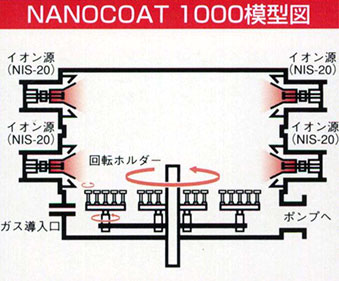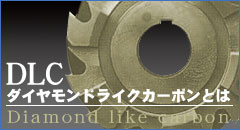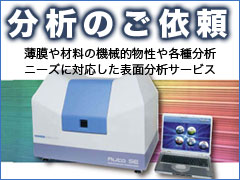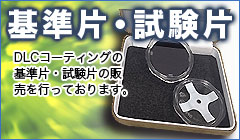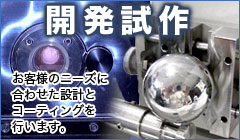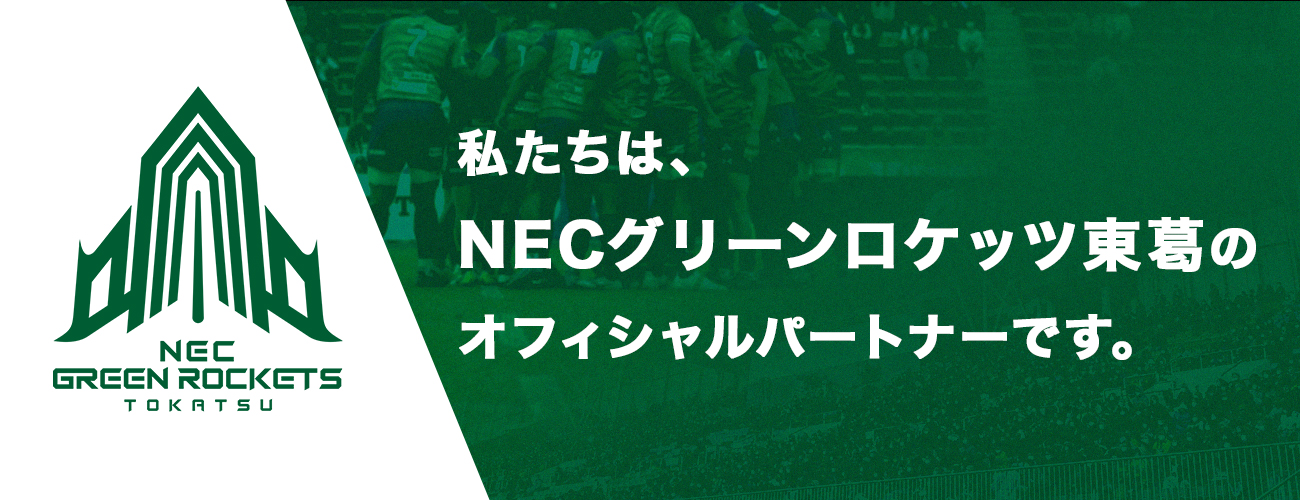For Further Information
TiKron(TM) thin film is a two-layer film consisting of a TiN layer on top of a CrN layer. TiKron is produced in the NTH-1000 by the same ion-plating process by which CrN and TiN thin-films are produced. TiKron offers the thermal and corrosion protection of CrN and the chemical stability and golden color of TiN. TiKron is especially useful for aluminum melt processing applications.
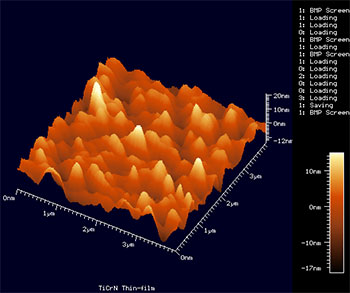
4 um X 4 um Scan of TiKron(TiCrN) Thin-film on Tool Steel
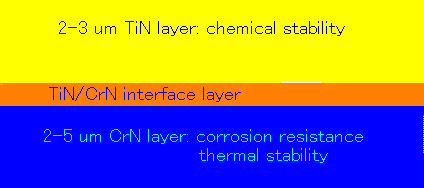
Process Characteristics
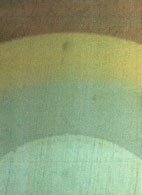
- Process temperature: 400-500° C
- Thin-film thickness: 2-7um
- maximum coating area: 200mm dia. X 400mm height
- materials we can coat:
- machine tool steel
- high speed steel
Current Applications
- aluminum die cast pins
- rubber and plastic forming molds and dies
- press molds
- high temperature shaping molds
CrN thin film, produced by our HCD (hollow cathode deposition) process, is availible up to 15 microns thick for your tool coating applications. CrN is produced by our NTH-1000 using the same ion plating process as TiN.
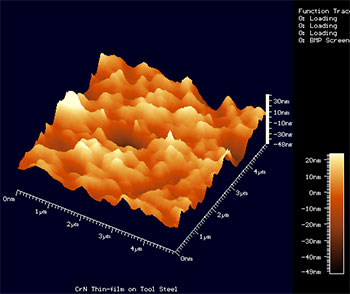
4 um X 4 um Scan of CrN Thin-film on Tool Steel
Process Characteristics
- Process temperature: 200-500° C
- Thickness of CrN film: 2-20um
- Maximum deposition area: 200mm dia. X 400mm height
- Materials that we can coat with CrN:
- machine tool steel
- high speed steel
- stainless steel
- WC-Co
CrN is produced by the electron bombardment of a chromium source by hollow cathode discharge. The resulting evaporant reacts with nitrogen gas which is continually feed into the chamber. The resulting thin film can be CrN, Cr2N, or a mixture of both, depending on the mass flow rate of nitrogen used during the deposition.
Compared with TiN thin film, CrN offers a lower coefficient of friction as well as greater resistance to lock-up during movement. As such, CrN thin film is more suitable for tribological applications. CrN also offers greater thermal resistance and acid-base corrosion resistance than does TiN thin film.
Friction test with tribometer
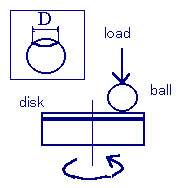
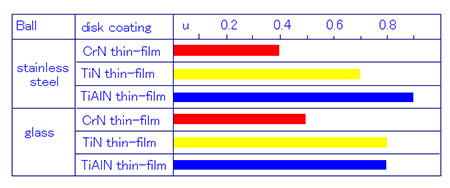
Current Applications
- Molds and dies
- press molds
- rubber forming molds
- glass forming molds
- drawing dies
- Mechanical Parts
- piston rings
- compresser shoes
- pump pins
- pump plungers
- textile machine parts
- Cutting tools
- copper alloy processing tools
Process Parameters
- Process temperature: 200-500° C
- Thickness of CrN film: 2-5um
- Maximum deposition area: 200mm dia. X 400mm height
- Materials that we can coat with TiN:
- machine tool steel
- high speed steel
- stainless steel
- WC-Co
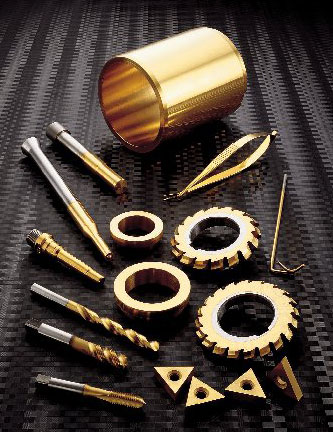
TiN is produced by the bombardment of a titanium source by glow discharge. The resulting evaporant reacts with nitrogen gas which is continually feed into the chamber. The resulting thin-film has the golden-yellow color characteristic of TiN.
Compared with uncoated tools, TiN coated tools offer extended life-times and reduced downtime due to tool wearout.
Current Applications
- press molds
- rubber forming molds
- glass forming molds
- drawing dies
What is DLC?
Carbon usually exists in several forms; graphite, diamond, and the new form of fullerines. All three of these forms are crystalline in structure but have varying properties based on the bonding order of the carbon atoms. Diamond-like carbon (DLC), on the other hand, is amorphous in structure, containing both SP2 and SP3 bonded carbon. As such, DLC has both diamond-like and graphitic properties. Hence the name diamond-like carbon (DLC).
An AFM scan of DLC Thin-film
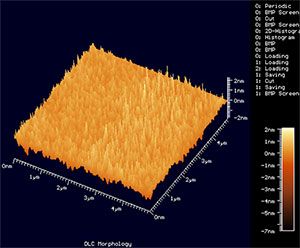
4 um X 4 um Scan of DLC Thin-film on Si Wafer
How DLC is made
Carbon usually exists in several forms; graphite, diamond, and the new form of fullerines. All three of these forms are crystalline in structure but have varying properties based on the bonding order of the carbon atoms. Diamond-like carbon (DLC), on the other hand, is amorphous in structure, containing both SP2 and SP3 bonded carbon. As such, DLC has both diamond-like and graphitic properties. Hence the name diamond-like carbon (DLC).
An AFM scan of DLC Thin-film
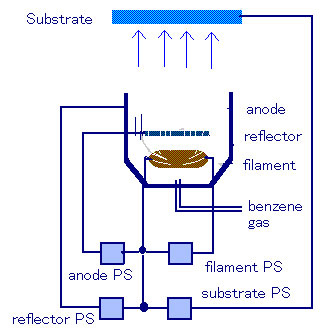
DLC thin-film is produced in the high-vacumn environment inside the Nanocoat 1000 machine chamber by a physical vapor deposition (PVD) process. During the PVD process, benzene is disassociated and ionized by a DC arc discharge (plasma). The resulting ions migrate towards the substrate to be coated which is negatively biased relative to the plasma. Collisions between ions in the gas phase result in the formation of both SP2 and SP3 bonded carbon structures which are then deposited on the substrate surface. As this is a PVD process, no chemistry takes place on the substrate surface and, thus, the substrate temperature can be less than 200° C.
DLC Ion Gun Diagram
Tribological Properties
DLC thin-film has an amorphous structure which is lacking in crystal grains. DLC has a much smoother surface than TiN. Nanotec’s DLC has an average roughness of 7 angstroms whereas a typical TiN film has an average roughness of 110 angstroms. This exceptional smoothness, along with hardness, results in DLC’s superior tribological properties as well as other properties such as wear-resistance, chemical inertness, build-up resistance, and low friction coefficient.

DLC and TiN Thin-films – Roughness Comparison
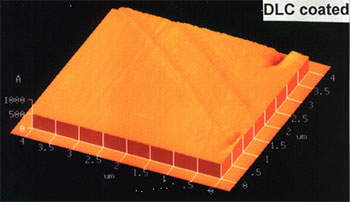
DLC Thin-film on Si Wafer – average roughness: 7 angstroms
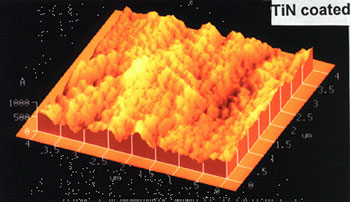
TiN Thin-film on Si Wafer – average roughness: 110 angstroms
The results of a ball-on-disk tribology test is shown below. This test measures the friction coefficient between the ball and coated disk as well as the diameter of the wear spot on the ball. The test consists of rotating a disk which has been coated with the thin-film to be tested under a stationary ball with a given load applied. An aluminum ball was used in this test. The materials tested included WC-Co (uncoated), DLC, TiN, CrN, TiCN, TiAlN thin-films. As shown below, the DLC thin-film out-performed the other materials for both friction coefficient and ball wear.
Diagram of tribology test
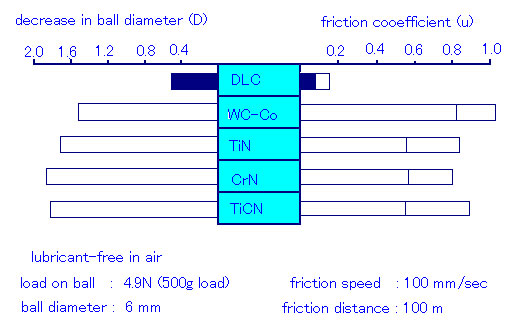
tribology test using aluminum ball
Current DLC Applications Include….
- Aluminum Can Production Tools
- IC Chip Assembly Tools
- WC Press Molds for Ceramics Processing
- Magnetic Tape Recorder Components
- Non-linear Lens Forming Dies
- Blades and Slitters Used for Cutting Aluminum
Custom DLC Thin-film Techniques
In addition to our regular DLC thin-film, we now offer ion implanted DLC (such as Si:DLC or N:DLC) as well as metal-doped DLC (MDLC). All of these DLC thin-films can be produced by our Nanocoat 1000 machine by use of our modular ion-implant and magnetron sputter units. These modular units can be retrofitted to any existing Nanocoat 1000 machine.
Regular DLC Thin-film
single DLC layer
produced by NIS-20 DLC ion source
low friction coefficient
current applications include molds, dies, and moving parts
Ion Implant DLC Thin-film
ion implanted material (Si,N) mixed in DLC single layer
produced by NIS-20 DLC ion source and NMS-40 ion implanter
customization of DLC film for specific applications
current applications include optical lenses and optical components
MDLC Thin-film
metal-containing DLC thin-film, can be multi-layered
produced by NIS-20 DLC ion source and NSP-100 magnetron sputter source
low stress, thick films can be produced
current applications include molds, toothed gears, axial bearings, and moving parts
DASH-700: Multi-Processing Capability
The Multi-700 is the latest addition to our product line. It uses several PVD and other deposition techniques to deposit multi-layer thin-films. Current deposition techniques include: dc hot filament plasma PVD, ion-mixing(implantation), DC and RF magnetron sputter, and both cathodic arc and hollow cathode discharge ion plating. There are 5 flange ports which allow up to five process sources to be added to the chamber at one time.
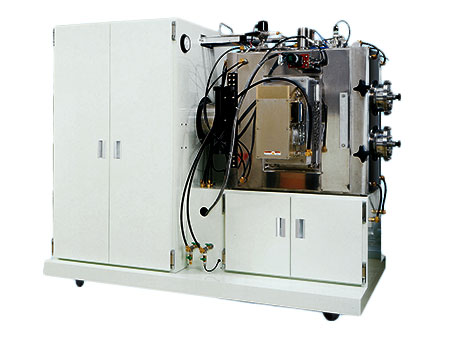
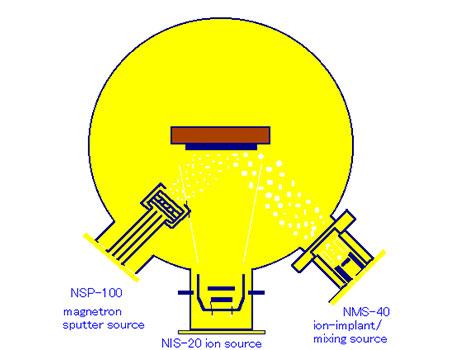
Current applications include:
- Ion Mixing DLC
- Sputtered WC-DLC
- Sputtered Si-DLC
NTH-1000 – HCD Ion Plating Equipment
The NTH-1000 uses a tandem hollow cathode discharge (HCD) technique to deposit high quality TiN, CrN, TiCN, and TiCrN thin films on cutting tools, machine parts, and molds.
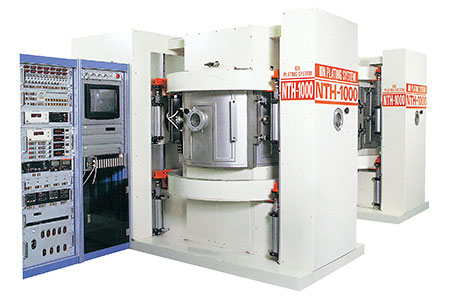 NTH-1000
NTH-1000
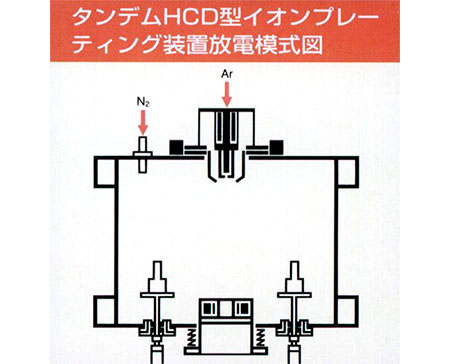
Being of modular construction, NTH-1000 coating capabilities may be enhanced by adding cathodic arc, DLC, and/or sputter sources to the port openings as your coating needs develop in the future.
The NTH-1000 utilizes a SCADA/MMI/PLC control system for convenient user operation. Control system features include:
- pentium-class computer with high-speed control link
- full graphical user interface
- process parameters set by downloadable speadsheet recipes
- one-button automatic process operation
- touch screen
DLC Deposition Equipment
We manufacture the Nanocoat 400 and Nanocoat 1000 PVD coating machines. The Nanocoat 400 is a small scale process machine intended for research applications. Our standard machine is the Nanocoat 1000 which is ideal for production applications. Both machines use the NIS-20 dc ion source in order to ionize the benzene and deposit DLC thin-film. The Nanocoat 400 uses one NIS-20 ion source whereas the Nanocoat 1000 can use up to four NIS-20 ion sources.
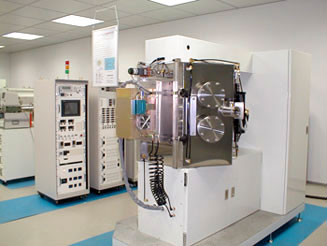 Nanocoat-1000
Nanocoat-1000
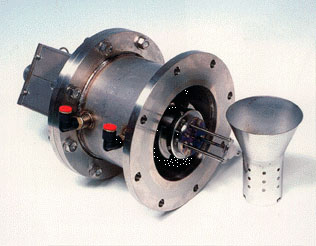 NIS-20 Ion Source
NIS-20 Ion Source
